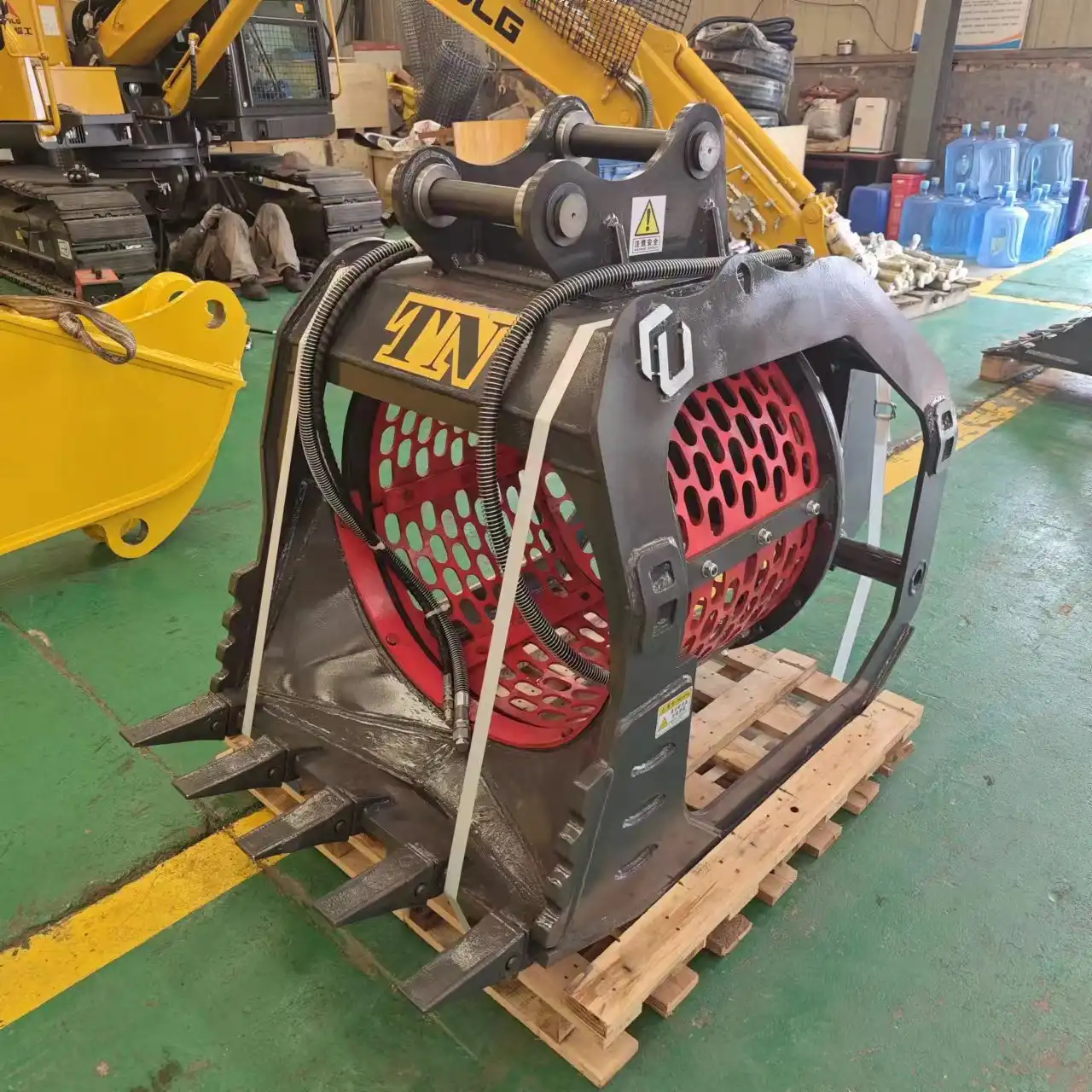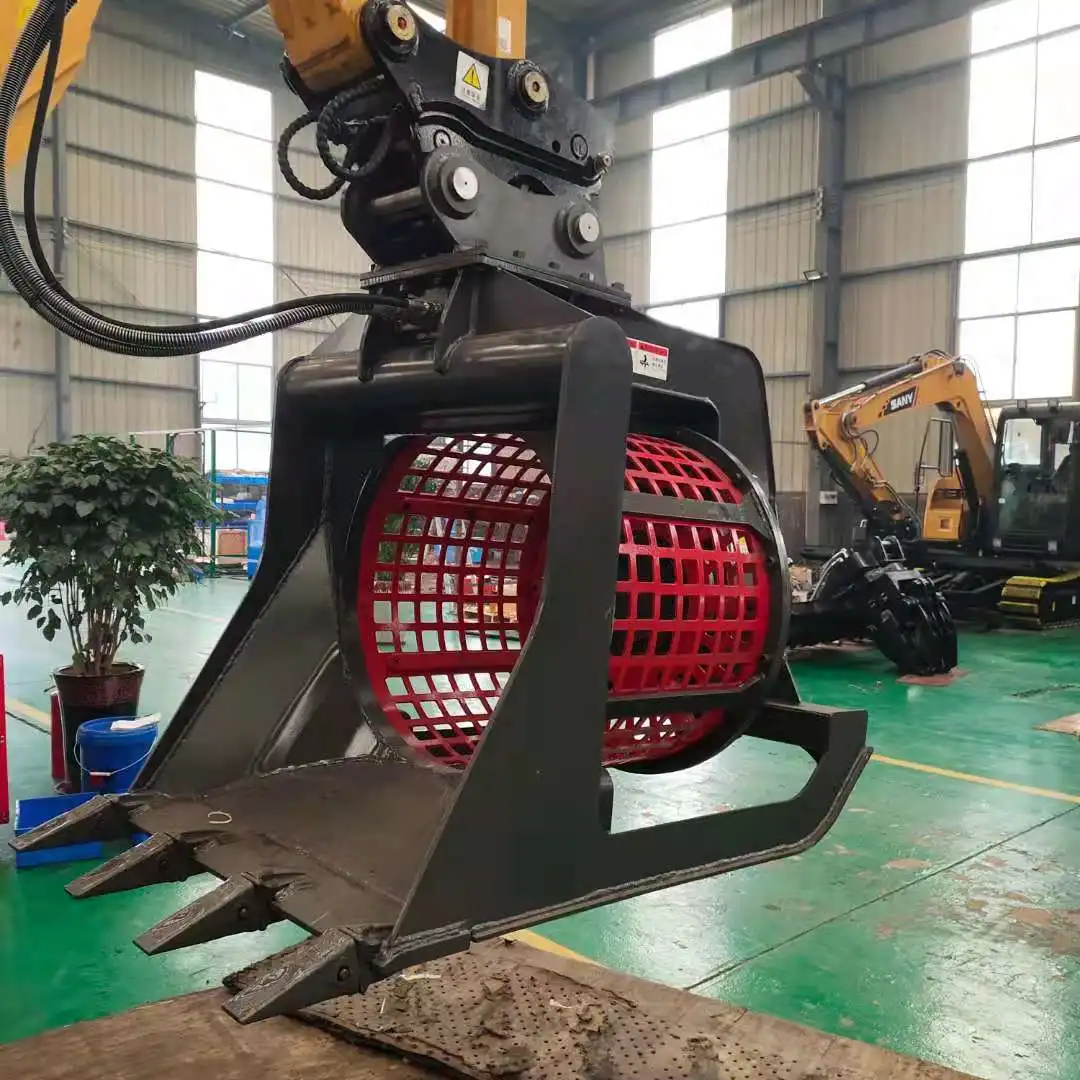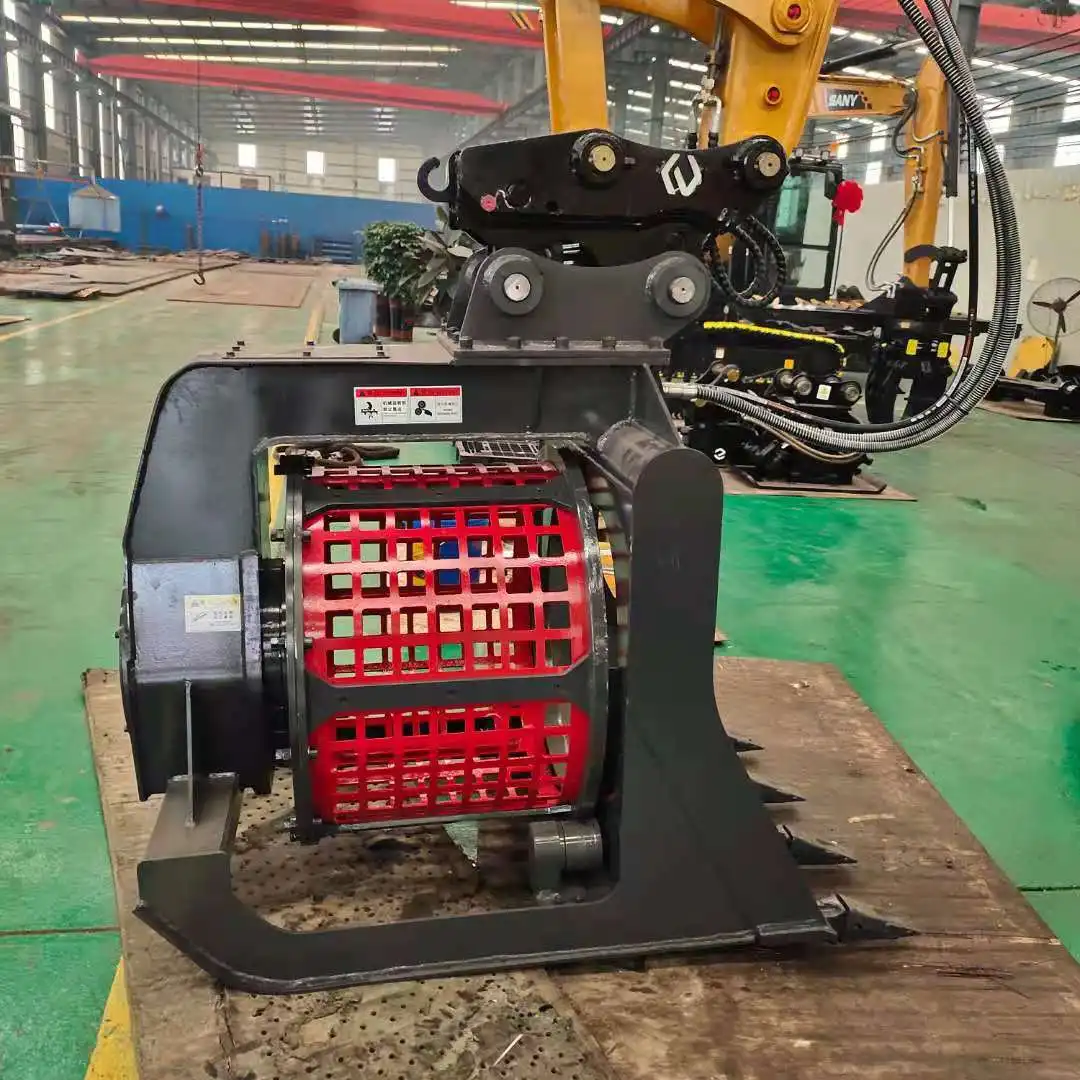How does a rotary screening bucket work?
An excavator rotary screening bucket is a versatile attachment that revolutionizes material processing on construction sites, quarries, and recycling facilities. This innovative tool works by harnessing centrifugal force to efficiently separate and sort various materials. As the bucket rotates, materials are forced against a cylindrical screen, allowing smaller particles to pass through while retaining larger objects. This process enables quick and effective separation of soil, gravel, sand, and debris, streamlining operations and reducing the need for additional equipment.

Key Components of Rotary Screening Buckets
Rotary drum: Heart of the screening process
The rotary drum is the core component of a screening bucket, designed to withstand the rigors of continuous rotation and material impact. Constructed from durable materials like high-strength steel, the drum features a perforated surface with precisely sized openings. These openings act as a sieve, allowing smaller particles to pass through while retaining larger objects. The drum's design optimizes the screening process, ensuring efficient material separation and minimizing the risk of clogging or damage.
Hydraulic drive system: Powering the rotation
A robust hydraulic drive system is crucial for the seamless operation of rotary screening buckets. This system typically consists of a hydraulic motor, valves, and hoses that connect to the excavator's existing hydraulic circuit. The hydraulic drive provides the necessary torque to rotate the drum, even when filled with heavy materials. Advanced systems often include adjustable speed controls, allowing operators to fine-tune the rotation speed based on the specific material being processed and desired outcome.
Mesh screens: Customizable for various materials
The mesh screens are integral to the bucket's versatility. These interchangeable components come in various sizes and configurations, tailored to suit different material types and desired end products. From fine mesh for sand and topsoil to larger openings for rocks and debris, the ability to swap out screens quickly enhances the bucket's adaptability across diverse job sites. Some advanced models even feature self-cleaning mechanisms to prevent blockages and maintain optimal performance throughout operation.
Step-by-Step Process Breakdown
Material loading: Filling the screening bucket
The process begins with loading the rotary screening bucket. The excavator operator maneuvers the attachment into a pile of mixed materials, such as excavated soil or demolition debris. As the bucket is filled, it's essential to avoid overloading, which could impair the screening efficiency. Some models feature load-sensing technology that automatically adjusts the rotation speed based on the material volume, ensuring consistent performance regardless of load variations.
Rotation and separation: How materials are sorted
Once loaded, the hydraulic system activates, initiating the drum's rotation. As the bucket spins, centrifugal force pushes the materials against the perforated surface of the drum. Smaller particles that fit through the mesh openings are expelled, while larger objects remain inside the bucket. This continuous rotation creates a cascading effect, thoroughly mixing and separating the materials. The rotation speed can be adjusted to optimize separation efficiency for different material types and moisture contents.
Discharge: Collection of screened materials
As the screening process continues, the separated materials are discharged in distinct streams. Finer particles pass through the mesh and fall beneath the bucket, creating neat piles of sorted material ready for use or further processing. Larger objects retained within the bucket can be easily dumped in a designated area for additional handling or disposal. This simultaneous separation and discharge streamline the entire material processing workflow, significantly reducing the time and labor required for manual sorting.

Advantages Over Static Screening Methods
Increased efficiency: Faster material processing
Rotary screening buckets offer a substantial leap in efficiency compared to traditional static screening methods. The continuous rotation and cascading action ensure that materials are thoroughly mixed and exposed to the screening surface, maximizing the separation rate. This dynamic process can handle larger volumes of material in less time, dramatically increasing productivity on job sites. Additionally, the ability to screen and sort materials in a single pass reduces the need for multiple handling stages, further streamlining operations and minimizing equipment downtime.
Versatility: Adapting to different job requirements
One of the most significant advantages of rotary screening buckets is their remarkable versatility. These attachments can be quickly mounted on various excavator models, transforming standard earthmoving equipment into multi-functional processing units. The interchangeable mesh screens allow for rapid adaptation to different material types and size requirements, making them ideal for diverse applications such as topsoil preparation, aggregate recycling, and waste management. This flexibility eliminates the need for multiple specialized machines, reducing equipment costs and simplifying logistics for contractors and site managers.
On-site screening: Reducing transportation costs
By enabling on-site material processing, rotary screening buckets significantly reduce the need for off-site screening facilities and associated transportation costs. Materials can be screened and sorted directly at the excavation or demolition site, allowing immediate reuse of suitable materials and minimizing the volume of waste that needs to be transported off-site. This not only leads to substantial cost savings but also contributes to more sustainable construction practices by reducing fuel consumption and carbon emissions associated with material transportation.
Rotary screening buckets have revolutionized material processing in various industries, offering unparalleled efficiency and versatility. By harnessing the power of centrifugal force and innovative design, these attachments streamline the separation and sorting of diverse materials directly on-site. The combination of key components like the rotary drum, hydraulic drive system, and customizable mesh screens enables precise control over the screening process, adapting to a wide range of job requirements. As the construction and recycling industries continue to evolve, rotary screening buckets stand out as indispensable tools for improving productivity, reducing costs, and promoting sustainable practices.

FAQ
1. What types of materials can be processed with a rotary screening bucket?
Rotary screening buckets can process a wide range of materials, including soil, sand, gravel, compost, demolition debris, and recycled materials. The versatility of these attachments makes them suitable for various industries such as construction, landscaping, and waste management.
2. How does the mesh size affect the screening process?
The mesh size directly impacts the size of particles that can pass through the screen. Smaller mesh sizes are used for finer materials like sand, while larger openings are suitable for coarser materials such as gravel. Choosing the appropriate mesh size is crucial for achieving the desired output quality.
2. Can rotary screening buckets handle wet or sticky materials?
Yes, many rotary screening buckets are designed to handle wet or sticky materials. Some models feature self-cleaning mechanisms or special coatings that prevent material buildup. However, extremely wet or clay-rich materials may require additional considerations or pre-processing for optimal results.
4. How does the rotation speed affect screening efficiency?
The rotation speed can significantly impact screening efficiency. Higher speeds generally increase throughput but may reduce separation accuracy. Lower speeds can improve separation quality but may slow down the process. Many modern rotary screening buckets allow operators to adjust the speed to find the optimal balance for specific materials and conditions.
5. Are rotary screening buckets suitable for small-scale operations?
Absolutely. Rotary screening buckets are available in various sizes to suit different excavator classes, making them suitable for both large-scale projects and smaller operations. Their versatility and efficiency can benefit projects of all sizes by reducing labor costs and improving material management.
China Excavator Rotary Screening Bucket Supplier
TianNuo Machinery, a leading manufacturer of excavator attachments in China, offers a comprehensive range of screening buckets designed to meet diverse industry needs. Their product line includes high-quality screening buckets compatible with excavators ranging from 6 to 40 tons, featuring customizable sieve hole sizes from 5 to 80 mm. These robust attachments, crafted from Hardox wear-resistant steel, can significantly reduce crushing time by up to 60%, enhancing material recovery and management efficiency. In addition to screening buckets, TianNuo Machinery produces a wide array of excavator accessories and modifications, including extended arms, specialized buckets, and hydraulic attachments. For inquiries about their excavator rotary screening buckets or other products, interested parties can contact us at boom@stnd-machinery.com.
References
- Smith, J. (2023). "Advancements in Excavator Attachments: Focus on Rotary Screening Buckets." Construction Equipment Magazine, 45(3), 78-85.
- Chen, L., & Wang, H. (2022). "Efficiency Analysis of Rotary Screening Buckets in Construction Waste Management." Journal of Construction Engineering, 18(2), 210-225.
- Peterson, A. (2023). "Innovative Screening Technologies in Modern Mining Operations." Mining Technology Today, 7(4), 112-120.
- International Association of Equipment Manufacturers. (2023). "Excavator Attachments Industry Report 2023: Trends and Market Analysis."
- Brown, R., & Davis, M. (2022). "On-Site Material Processing: Environmental and Economic Impacts." International Journal of Recycling and Waste Management, 12(1), 45-58.
- TianNuo Machinery. (2023). "Rotary Screening Bucket Specifications and Applications Guide." Technical Documentation.
About Author: Arm
Arm is a leading expert in the field of specialized construction and railway maintenance equipment, working at Tiannuo Company. Tiannuo specializes in manufacturing a wide range of products, including railway maintenance equipment like railway sleeper changing machines and screening machines, excavator modification equipment such as excavator lifting cabs, various engineering arms for excavators, excavator accessories like digging buckets, and engineering vehicle auxiliary equipment like loader buckets.

